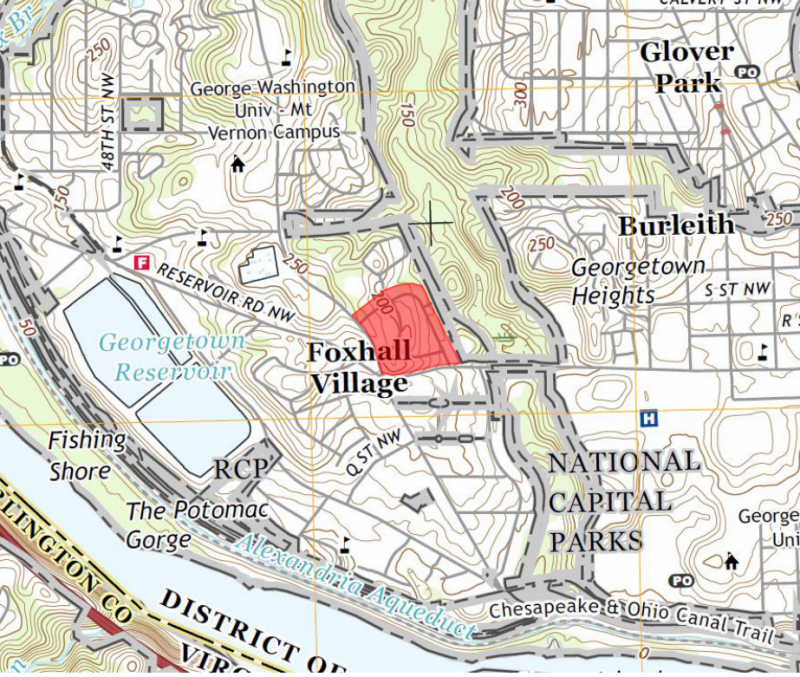A suburban development tests the limits of DC historic district designation

Proposed historic district map from the Colony Hill historic district application
A Ward 3 neighborhood’s nondescript historic district application will test the Historic Preservation Review Board’s minimum standards and raise further questions about preservation’s relationship to the history of racial segregation.
Colony Hill is a small development in Northwest DC, bordering the Foxhall, Palisades and Berkley neighborhoods. This July, the Colony Hill Neighborhood Association filed an application to designate the area a historic district, which would add the neighborhood to the National Register of Historic Places and subject the properties in it to stricter regulations around modifications to their exteriors.
The application is centered on the circumstances of the neighborhood’s construction. Developed largely in the 1930s, the community consists of 50 detached, single-family homes set along suburban-style curvilinear streets, two qualities that distinguish it from earlier DC neighborhoods characterized by rowhomes along a traditional street grid.
As the historic district application lays out, the location and the layout were both products of the increasing affordability and popularity of automobiles at the time. Their growing adoption made suburban locations like this — further from the city core and the streetcar lines — more attractive, and fueled a desire for more spacious houses that included garages.
The application also cites some general incorporation of Colonial Revivalist architectural features (an abundant architectural style seen in detached houses across DC) and an incorporation of landscape elements. But largely speaking it’s the social history reflecting “the evolution that occurred in residential development in Washington, D.C. during the twentieth century” that it relies on to make its case for historic designation.
Proposed historic district map from the Colony Hill historic district application 
Is it distinct enough?
What’s most notable about the application is less what’s in it, and more what isn’t. The District’s preservation law charges the Historic Preservation Review Board with designating “landmarks and districts which represent distinctive elements of the city’s cultural, social, economic, political and architectural history.” While this application highlights Colony Hill as an example of this residential history, it doesn’t claim the neighborhood is the only example, or even a particularly special one. It’s more a typical example of a wider trend.
For a city that already boasts a disproportionately large number of historic buildings, this doesn’t feel like a particularly necessary designation. If this application meets the standard, what neighborhoods wouldn’t qualify?
What merits an exception?
The board has recently shown a willingness to bend its guidelines for some applications. In the case of Barry Farm, it overruled Historic Preservation Office staff’s concerns that the buildings were not intact enough to qualify. And in the case of Kingman Park’s expansion, it stretched the legal criteria of the original application to designate some additional blocks to recognize notable individuals who lived there in the past.
However, both of those applications specifically sought to preserve Black history, which the applicants and the Board alike noted is significantly under-recorded and under-represented among the District’s historic inventory. In fact, the Board made an explicit point in each of these hearings to comment on the greater good of using historic designations to rectify this imbalance.
Colony Hill, on the other hand, is exactly the opposite. Not only is the present-day neighborhood an example of the kind of wealthier, whiter area that is already over-represented among the city’s historic districts, but de jure racial segregation is an explicit part of the history the application seeks to preserve.
The application details the development’s racial covenants, which were designed specifically to target wealthy white buyers who sought suburban communities that people of color would have no access to. That history of racism was by no means unique to this neighborhood, and broadly it’s still important history to record and learn from. But compared to the aforementioned cases where social history provided the Board a moral justification to break precedent, this is a clear foil.
The board is scheduled to hear this application at their meeting this month. Approving this historic district would not only preserve the history of another wealthy, white neighborhood, but by adding additional land-use restrictions to the houses here, it would help to keep it that way in perpetuity.
Given that the board has never rejected an application for a historic district (at least as far as long-time staff can remember), this application could present a crucial test case. Will the Board establish a baseline standard nominations need to clear? Or are historic districts basically available for any neighborhood that can afford to pay for a historic report? And, if so, what’s ultimately the point of historic preservation?
